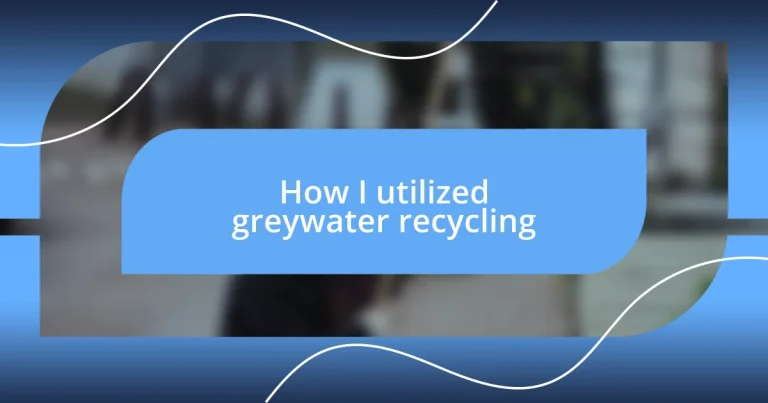Key takeaways:
- Greywater recycling offers emotional satisfaction and environmental benefits by repurposing wastewater for irrigation, contributing to water conservation.
- Choosing the right greywater system involves assessing personal needs and preferences, with options ranging from simple direct reuse to complex treatment systems.
- Regular maintenance, including cleaning filters and monitoring water usage, is crucial for ensuring the efficiency and function of greywater systems.
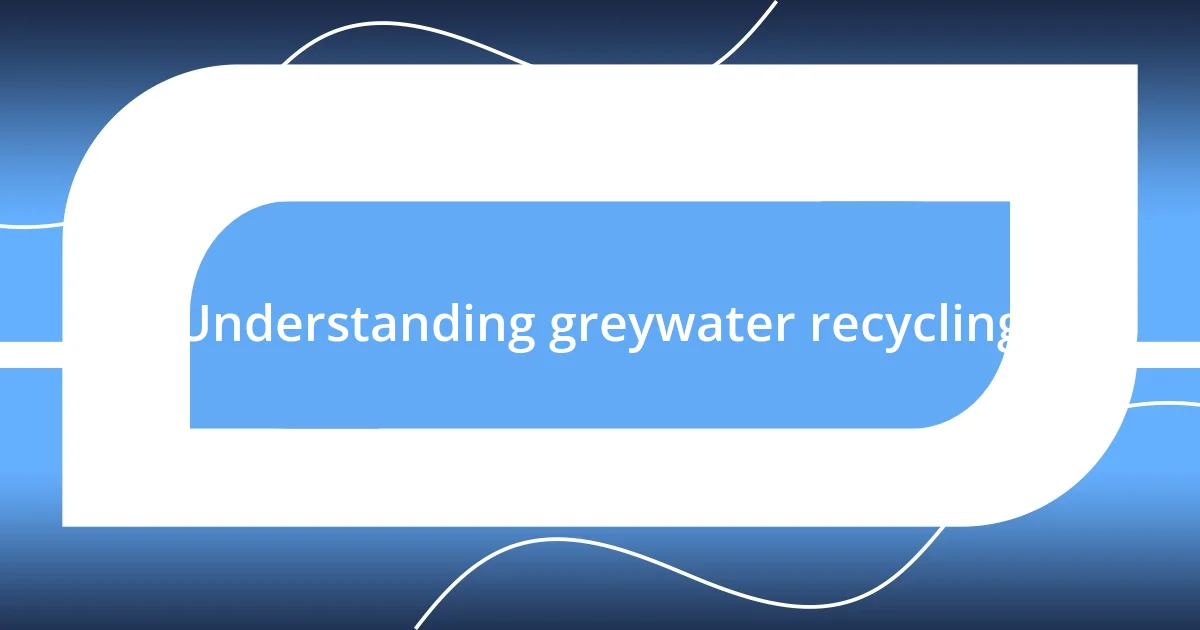
Understanding greywater recycling
Understanding greywater recycling can feel a bit overwhelming at first, but really, it’s about recognizing the value in what we often discard. When I first started looking into it, I was amazed to learn that greywater—wastewater from sinks, showers, and laundry—can actually be reclaimed for outdoor uses like irrigation. Isn’t it wild that something we routinely send down the drain holds potential to help us conserve water?
What struck me the most was the emotional satisfaction that comes from using a resource that would otherwise go to waste. I remember the first time I set up a simple greywater system in my backyard. Watching my plants thrive with the recycled water felt like I was nurturing life in a more responsible way. Doesn’t it bring joy to know you’re making a positive impact, even if it’s just in your own garden?
It’s essential to understand the difference between greywater and blackwater—the former being relatively clean, while the latter contains harmful pathogens from toilets. This distinction is key. If you’re like me, perhaps you’re now asking, “How can I start recycling greywater safely in my home?” Trust me, the journey has its challenges, but it’s one that’s deeply rewarding both for the planet and for our personal well-being.
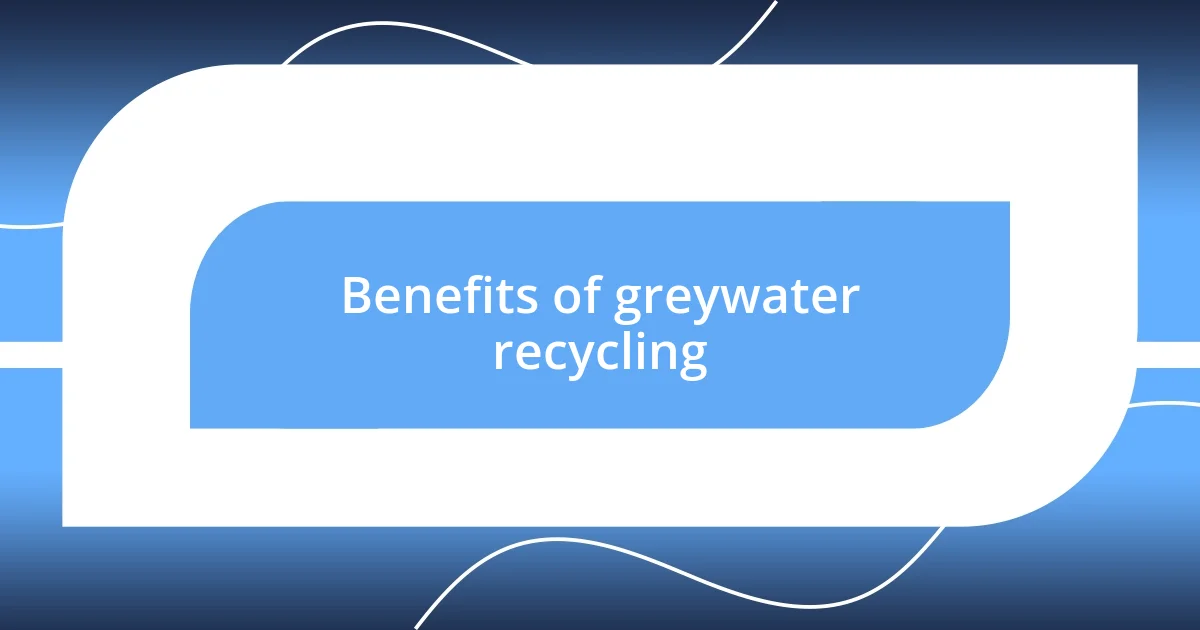
Benefits of greywater recycling
Utilizing greywater recycling has transformed my approach to water conservation. The most significant benefit I’ve observed is the substantial reduction in my household water consumption. It’s incredible to think that I can reuse water that would otherwise be wasted, especially during the peak summer months when my garden demands a lot of moisture. Each time I see my plants flourish, I feel a sense of pride, knowing that I’m helping the environment while also keeping my garden vibrant.
Another major perk I’ve experienced is the financial savings. Cutting down on utility bills by reusing greywater is something that brings a smile to my face. It’s fascinating how a small change in my daily routine—like redirecting water from the shower to the garden—can lead to noticeable savings. I remember the first time I analyzed my water bill after installing the system; seeing the decrease was a reassuring affirmation of my efforts.
Furthermore, greywater recycling contributes positively to the ecosystem. By using this water for irrigation, I’m not only supporting my plants but also reducing the burden on local sewage systems. This interconnectedness with nature feels incredibly fulfilling. The idea that my actions can lead to a healthier planet gives me a profound sense of responsibility and joy.
| Benefit | Description |
|---|---|
| Water Conservation | Allows for the reuse of water that would otherwise go to waste, significantly reducing overall consumption. |
| Cost Savings | Leads to lower water bills by cutting down on the need for fresh water for irrigation and other uses. |
| Environmental Impact | Reduces strain on sewage systems and supports local ecosystems through responsible water use. |
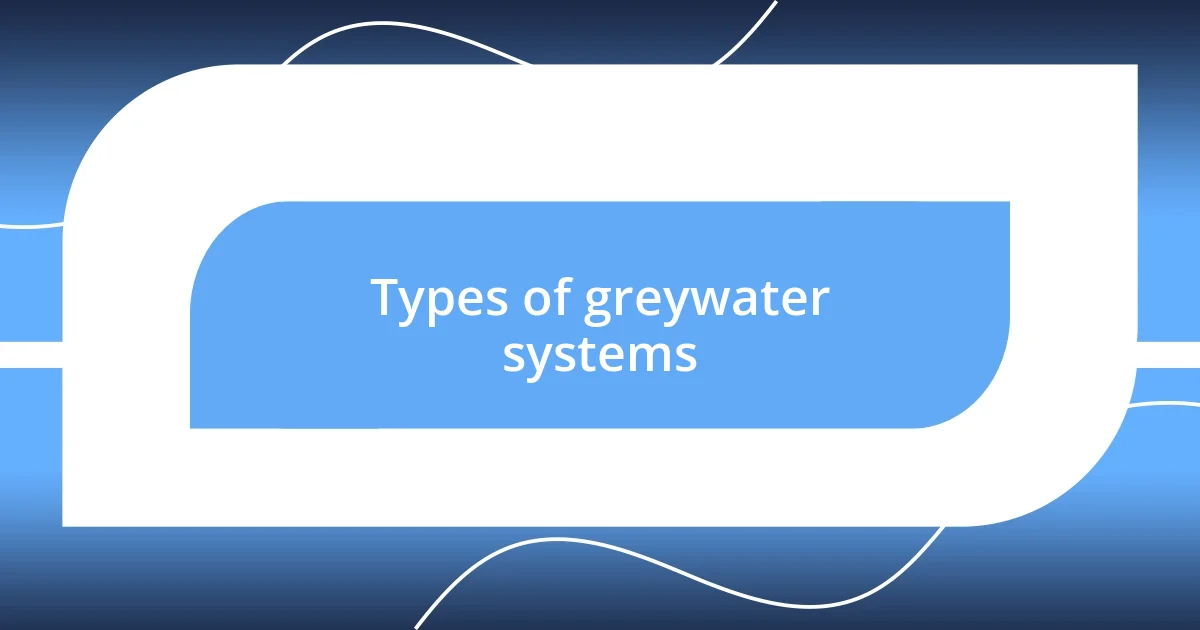
Types of greywater systems
When I dived into the world of greywater systems, I quickly realized there are various types to consider. Each system comes with its own set of advantages that can cater to different needs and preferences. I remember the moment I learned about the two most common systems: the direct reuse method and the more complex treatment systems. It was like uncovering a treasure trove of options that opened my eyes to how I could tailor my approach to greywater recycling.
- Direct Reuse Systems: These systems channel greywater directly from sources like sinks or showers to irrigation areas with little to no treatment, making it simple and efficient.
- Gravity-Fed Systems: Using gravity to move water, these systems often serve gardens by relying on natural slope, which resonates with my desire for low-maintenance solutions.
- Activated Sludge Systems: More sophisticated, these systems treat greywater to meet safety standards, which adds a layer of assurance that I find comforting.
- Constructed Wetlands: I was fascinated by this eco-friendly approach, utilizing plants and natural filtration to clean greywater while creating a lush habitat—what a beautiful way to combine function with nature!
Diving deeper into my own greywater system, I discovered that size and complexity can vary widely. I went for a minimalist approach, and it felt liberating to know that I could achieve meaningful results without complexity slowing me down. It’s remarkable how I can contribute to sustainability by simply modifying my water use at home. The joy I felt watching my garden flourish with re-purposed water was unlike anything I had experienced before, connecting me closely with my environment.
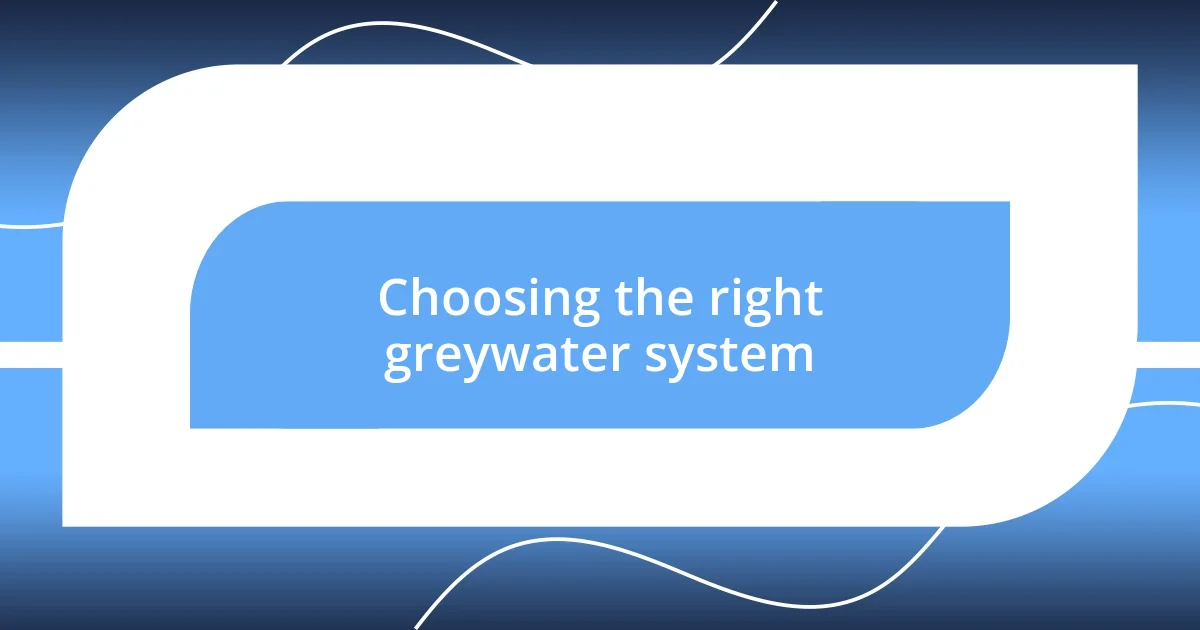
Choosing the right greywater system
When it came to choosing the right greywater system for my home, I had to weigh several factors to find the best fit for my lifestyle. I remember standing in my kitchen, contemplating whether a direct reuse system would suffice or if I should invest in a more complex treatment option. This decision felt significant; after all, I wanted something that would blend seamlessly into my daily routine without overwhelming me with maintenance tasks.
One particular moment stood out during my research phase: browsing through online forums, I stumbled upon a passionate discussion about gravity-fed systems. The idea of utilizing the natural landscape of my yard to move water effortlessly felt like a game-changer. Could something as simple as gravity really simplify my life while helping the environment? I took the plunge and was delighted at how this choice saved me time and effort, allowing me to focus on enjoying my thriving garden instead of worrying about system upkeep.
Ultimately, I discovered that trial and error can be perfectly okay when selecting a greywater system. After experimenting with different configurations, I found a balance between simplicity and efficiency that worked wonders for my household. I’ll admit, navigating the options was initially daunting, but each setback enriched my understanding of what to look for. Have you ever felt overwhelmed by choices, only to find clarity in trying out different paths? That’s precisely the realization that came to me, leading me to a solution that I genuinely value.
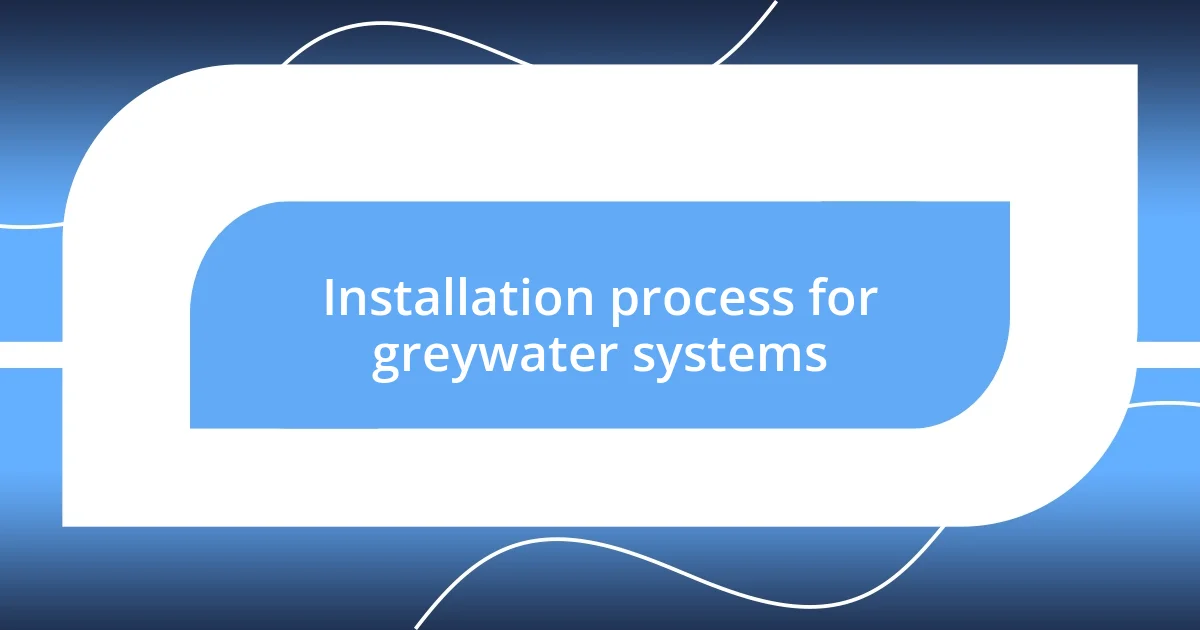
Installation process for greywater systems
Once I decided on the type of greywater system that fit my needs, the installation process was both exciting and a bit daunting. I can still picture myself in the backyard, armed with tools and determination, as I began the groundwork. I opted for a gravity-fed system, which required careful planning to ensure the proper slope for optimal water flow. Watching every step come together felt invigorating; it was as if I was constructing my own little water recycling oasis.
As I moved through the installation, I realized that attention to detail was crucial. I had to ensure that all connections were watertight and that the outlet areas incorporated proper drainage to avoid flooding my garden. I vividly remember that moment when I tested the system for the first time—literal water flowing where I’d intended brought an overwhelming sense of accomplishment. Did I get a bit nervous waiting for the first flow? Absolutely! But that joy was worth every ounce of uncertainty.
In hindsight, I’ve learned that patience plays a significant role in installing a greywater system. I also took time to read the local regulations to understand any necessary permits or guidelines. It’s easy to rush through this stage, but taking the time resulted in a reliable setup and peace of mind. Do I ever think about the small challenges I faced during installation? Sure, but those moments only enhanced my appreciation for the entire recycling process, making the water-saving benefits that much sweeter.
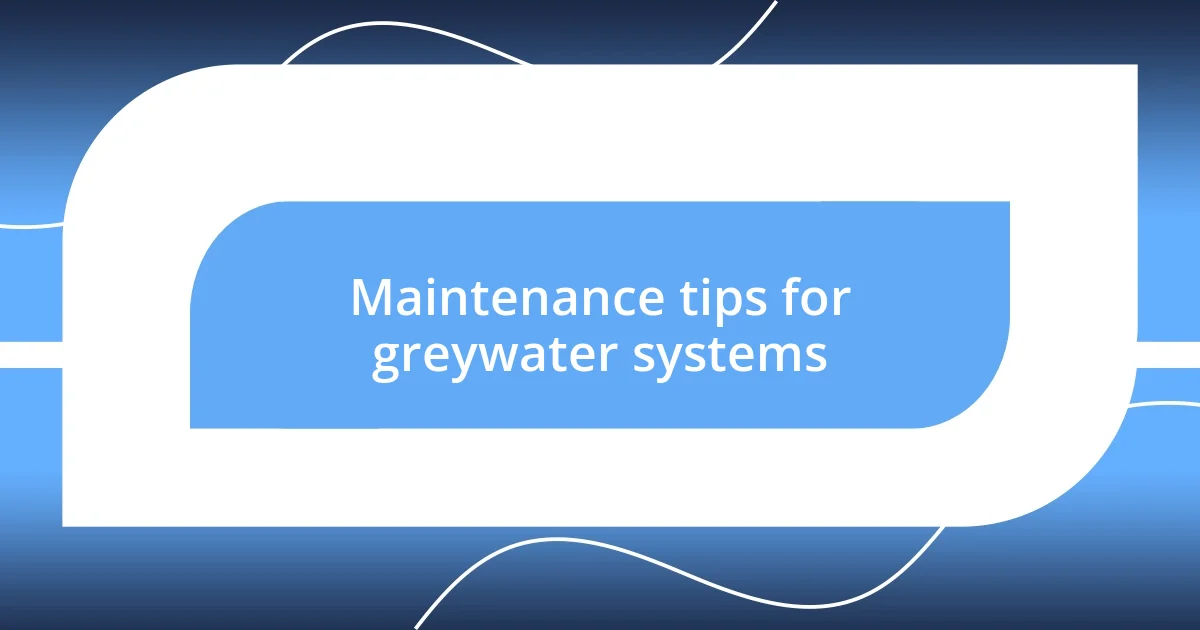
Maintenance tips for greywater systems
Maintaining a greywater system is essential to ensure it functions correctly and efficiently. I remember the first time I conducted a routine inspection; I felt both a bit nervous and excited, envisioning all the things that could go wrong. It turned out to be a simple check—just ensuring that my filters were clean and that there were no clogs. Regularly cleaning filters can prevent larger issues down the line and enhance the system’s efficiency.
Another key maintenance tip I’ve learned is to monitor the water usage patterns in my home. Adjusting the amounts of greywater being diverted based on my laundry or shower frequency made a world of difference. For instance, during the summer months when my garden needed extra watering, I became more deliberate with how I reused water. Have you ever considered how small changes in your routine could lead to better results? For me, it turned my daily water-saving efforts into a seamless part of my life.
Lastly, always remember to look out for any unusual odors or signs of leaks. I once noticed an odd smell near my system—immediately, my mind raced with concern. After inspecting it, I discovered that a small connection had come loose, which was a quick fix but could have led to bigger problems if I hadn’t caught it in time. It’s moments like these that remind me to stay vigilant and proactive; after all, prevention is much easier than rectifying a significant problem later on!












